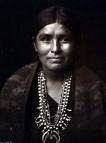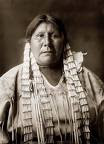Native Americans celebrate the land and their cultural traditions with stories told in languages unique to each tribe, dynamic dances, and colorful arts and crafts. Their culture influences many facets of live in New Mexico, most obviously the architectural styles and cuisine.
Archaeologists theorize that New Mexico Native American groups began evolving from 12,000 to 30,000 years ago. Many tribal elders teach the native American youth that their people evolved from the earth itself and are as unique to their homeland as the trees and terrain.
The descendants of these early people belong to as many as 22 distinct tribes today. Each maintains a separate, sovereign government and takes great care to preserve ancient traditions and language. The Pueblo culture is classified into three language groups : The Zunis, The Keres, and The Tanoans. Only Zuni people speak Zuni, The Keres speakers include The Pueblos of Acoma, Cochiti, Laguna, San Felipe, Santa Ana, Santa Domingo, and Zia.
Tanaons are divided into three subcategories : Tewa, Tiwa, Towa.
Tewa - speaking Pueblos include Nambe, Pojoaque, San Ildefonso, Santa Clara, Ohkay Owingeh ( formerly San Juan ) and Tesuque.
Tiwa - speaking Pueblos are Isleta, Picuris, Sandia and Taos.
Only Towa - speaking Pueblos is Jemes.
The historical nomadic Apache and Navajo people in the state are categorized into the Athapascan group. Many members of the Navajo Nations, however, do not believe in this scientific classification and, just as The Pueblo people, teach their young and the tribal version of beliefs about their origin. The Apaches and Navajos each migrated to the area in mid - 1500s, about the same time as the arrival of Spanish explorers.
The Pueblo Indians briefly united under Po'Pay and other leaders to rebel against religious repression and forced servitude by the Spanish in The Pueblo Revolt of 1680.
Many Spanish in Settlers fled, enabling the Ute, Navajo and Apache tribes to raid the Pueblo people in their absence.
When the Spanish returned a dozen years later, the Pueblo people allied with the colonistas, against the nomadic raiders.
The Spanish offred land grants t people of mixed heritage ( mestizos as genizaros ) to establish isolated settlerments as buffers against hostile raiders between the frontier and more populated areas, such as Santa Fe.
In the 1800s, The United States territorial government also battled the raiding warriors. The government relocated the Navajo and Apache people several times, including a forced march of 8,500 people to the Bosque Redondo Indian Reservation in 1860s.
American Indians didn't achieve U.S . citizenship and the right to vote nationally until 1924. They were granted suffrage in New Mexico elections in 1948 and guaranted religious freedom by federal law in 1978.
Native Americans have served in every U.S military confilct sine World War I. The Navajo Code Talkers, who communicated secret strategy over the airwaves in the complex Navajo language, where vital to the United States Victory in World War II.
Today, many of the native American tribes have established business enterprises such as casinos, resorts, and sporting venues to improve life for their people and ensure their government's sovereign status.
Archaeologists theorize that New Mexico Native American groups began evolving from 12,000 to 30,000 years ago. Many tribal elders teach the native American youth that their people evolved from the earth itself and are as unique to their homeland as the trees and terrain.
The descendants of these early people belong to as many as 22 distinct tribes today. Each maintains a separate, sovereign government and takes great care to preserve ancient traditions and language. The Pueblo culture is classified into three language groups : The Zunis, The Keres, and The Tanoans. Only Zuni people speak Zuni, The Keres speakers include The Pueblos of Acoma, Cochiti, Laguna, San Felipe, Santa Ana, Santa Domingo, and Zia.
Tanaons are divided into three subcategories : Tewa, Tiwa, Towa.
Tewa - speaking Pueblos include Nambe, Pojoaque, San Ildefonso, Santa Clara, Ohkay Owingeh ( formerly San Juan ) and Tesuque.
Tiwa - speaking Pueblos are Isleta, Picuris, Sandia and Taos.
Only Towa - speaking Pueblos is Jemes.
The historical nomadic Apache and Navajo people in the state are categorized into the Athapascan group. Many members of the Navajo Nations, however, do not believe in this scientific classification and, just as The Pueblo people, teach their young and the tribal version of beliefs about their origin. The Apaches and Navajos each migrated to the area in mid - 1500s, about the same time as the arrival of Spanish explorers.
The Pueblo Indians briefly united under Po'Pay and other leaders to rebel against religious repression and forced servitude by the Spanish in The Pueblo Revolt of 1680.
Many Spanish in Settlers fled, enabling the Ute, Navajo and Apache tribes to raid the Pueblo people in their absence.
When the Spanish returned a dozen years later, the Pueblo people allied with the colonistas, against the nomadic raiders.
The Spanish offred land grants t people of mixed heritage ( mestizos as genizaros ) to establish isolated settlerments as buffers against hostile raiders between the frontier and more populated areas, such as Santa Fe.
In the 1800s, The United States territorial government also battled the raiding warriors. The government relocated the Navajo and Apache people several times, including a forced march of 8,500 people to the Bosque Redondo Indian Reservation in 1860s.
American Indians didn't achieve U.S . citizenship and the right to vote nationally until 1924. They were granted suffrage in New Mexico elections in 1948 and guaranted religious freedom by federal law in 1978.
Native Americans have served in every U.S military confilct sine World War I. The Navajo Code Talkers, who communicated secret strategy over the airwaves in the complex Navajo language, where vital to the United States Victory in World War II.





